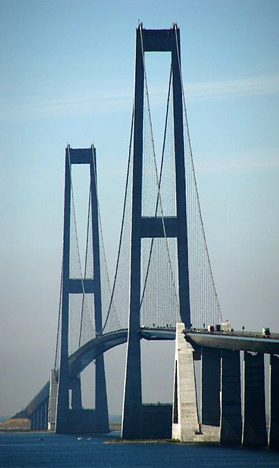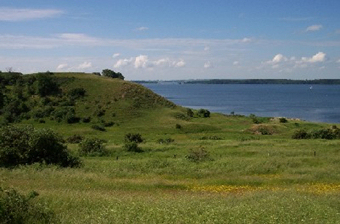|

The Great Belt Brigde
Denmark
List of all "Spotlights"
| |
SPOTLIGHT ON ENVIRONMENT AND HEALTH IN DENMARK
Danish Association of Nature and Environment Protection Officers,
EnviNa (Denmark)
Denmark is a Scandinavian country in Northern Europe. The country of Denmark, together with Greenland and the Faeroe Islands, comprises the Kingdom of Denmark.
Denmark is a constitutional monarchy with a parliamentary system of government. Denmark has a state-level government and local governments in 98 municipalities. Denmark has been a member of the European Union since 1973, although it has not joined the Euro-zone. Denmark is a founding member of NATO and the OECD. Denmark is also a member of the Organisation for Security and Cooperation in Europe (OSCE).
The national language, Danish, is closely related to Swedish and Norwegian, with which it shares strong cultural and historical ties. 80.9% of the inhabitants of Denmark are members of the Lutheran state church.
Denmark has a market economy and a one of the most developed welfare systems in the world.
Denmark has one of the highest GDP's per capita in the world, and is also one of the worlds strongest export nations measured per capita. The economy is modern, diversified and highly industrialized. Export articles are Lego toys, Grundfos pumps, Danfoss products, Carlsberg beer, Bang & Olufsen TV´s and Hi-Fi, Novo insulin, and numerous other products and know-how. The country also houses the World largest container shipping company, Maersk.
Denmark is fulfilling the criteria for being a Euro-zone member, but after a referendum the Government had to leave the country outside the EU monetary system. The income distribution is one of the most even in the world. Denmark has the best business climate in the world, according to the U.S. business magazine Forbes. From 2006 to 2008, surveys ranked Denmark as "the happiest place in the world", based on standards of health, welfare and education. The 2009 Global Peace Index survey ranks Denmark as the second most peaceful country in the world, after New Zealand. In 2009, Denmark was ranked as one of the least corrupt countries in the world according to the Corruption Perception Index, ranking second only to New Zealand. In 2010, Transparency International ranked it as the least corrupt country in the world, in a three-way tie with New Zealand and Singapore. The capital of Denmark, Copenhagen, has repeatedly in European surveys been chosen as the best city to live in.
Demographics
Denmark’s population is 5,475,791, giving Denmark a population density of 129.16 inhabitants per km2 (334.53 inh/sq mi). As in most countries, the population is not distributed evenly. Although the land area east of the Great Belt only makes up 9,622 km² (3,715 sq mi), 22.7% of Denmark's land area, it has 45% (2,465,348) of the population.
As of 2010, 548,000 persons (9.9% of the Danish population) were either immigrants or descendants of recent immigrants. Most of these (54%) have their origins in Scandinavia or elsewhere in Europe, while the remainder originate mainly from Middle Eastern and African countries.
The average fertility per woman in Denmark is 1,8 leading to a forecasted population decline.
Geography
Denmark shares a border of 68 kilometres with Germany to the south and is otherwise surrounded by 7,314 kilometres of coastline. It occupies 43,094 square kilometres.
Denmark's northernmost point is Skagens point (the north beach of the Skaw) at 57° 45' 7" northern latitude; the southernmost is Gedser the southern tip of Falster at 54° 33' 35" northern latitude; the westernmost point is Blåvandshuk at 8° 4' 22" eastern longitude; and the easternmost point is Østerskær 55" eastern longitude. This is in the archipelago Ertholmene 18 kilometres northeast of Bornholmance from east to west is 452 kilometres (281 mi), from north to south 368 kilometres (229 mi).
Denmark consists of the peninsula of Jutland (Jylland) and 443 named islands (1,419 islands above 100 m² in total). Of these, 72 are inhabited, with the largest being Zealand (Sjælland) and Funen (Fyn). The island of Bornholm is located east of the rest of the country, in the Baltic Sea. Many of the larger islands are connected by bridges; the Øresund Bridge connects Zealand with Sweden; the Great Belt Bridgeconnets Funen with Zealand; and the Little Belt Bridge connects Jutland with Funen. Ferries or small aircraft connect to the smaller islands. Main cities are the capital Copenhagen on Zealand; Aarhus, Aalborg and Esbjerg in Jutland; and Odense on Funen.

The
Great Belt bridge
The country is flat with little elevation; having an average height above sea lavel of 31 metres (102 ft). The highest natural point is Møllehøj, at 170,86 metres (560,56 ft). Other hills in the same area southwest of Århus are Yding Skovhøj at 170,77 metres (560,27 ft) and Ejer Bavnehøj at 170,35 metres (558,89 ft). The area of inland water is: east of the Great Belt 210 km2 (81 sq mi) and west of the Great Belt 490 km2 (189 sq mi).
No location in Denmark is further from the coast than 52 km (32 mi). The size of the land area of Denmark cannot be stated exactly since the ocean constantly erodes and adds material to the coastline, and because of human land reclamation projects (to counter erosion). On the south west coast of Jutland, the tide is between 1 and 2 m (3.28 and 6.56 ft), and the tide line moves outward and inward on a 10 km (6.2 mi) stretch.
Climate
The climate is in the temperate zone. The winters are not particularly cold, with mean temperatures in January and February of 0.0 °C, and the summers are cool, with a mean temperature in August of 15.7 °C. Denmark has an average of 121 days per year with precipitation, on average receiving a total of 712 mm per year; autumn is the wettest season and spring the driest.

Winter scenery – Viborg, a city in central Jutland
Environment
Denmark has historically taken a progressive stance on environmental preservation; in 1971 Denmark established a Ministry of Environment and was the first country in the world to implement an environmental law in 1973.
To mitigate environmental degradation and global warming the Danish Government has signed the following international agreements: Antarctic Treaty; Climate Change-Kyoto Protocol; Endangered Species Act. These agreements have helped in the reduction in CO2 emissions by Denmark.

Beautiful nature – fiord and a small valley, one of the
very finest botanical locations in the country. Isefjorden and Ejby Ådal.
Denmark was ranked as the 10th best country in the world for "Living Green" by a 2007 Readers Digest survey, and Copenhagen is recognised as one of the most environmentally friendly cities in the world. Much of the city's success can be attributed to a strong municipal policy combined with a sound national policy. In 2006 Copenhagen Municipality received the European Environmental Management Award. The award was given for long-term holistic environmental planning. Recently many of Denmarks smaller Municipalities such as Lolland and Bornholm have also become environmental leaders. Denmark is home to five of the world's ten largest central solar heating plants (CSHP). The world's largest CSHP is situated in the small community of Marstal on the island of Ærø.
Denmark's green house gas emissions per dollar of value produced has been for the most part unstable since 1990, seeing sudden growths and falls. Overall though, there has been a reduction in gas emissions per dollar value added to its market. It is comparable to countries such as Germany, but lagging behind other Scandinavian countries such as Norway and Sweden.
In 2009 the Danish average green house gas emission per inhabitant was between 13 and 14 tonnes.
ENVINA – Danish Association of Environment and Nature Protection Officers has just about 1.600 members. The officers are primarily working for the local governments, but members from the Regional level and from the Federal level do appear.
The local governments are in general responsible for most of the environmental protection:
- Licensing, inspection and enforcement of the vast majority of industrial sites
- Farm inspections
- Nature protection, and nature preservation according to National and European Union regulations
- Drinking water quality
- Soil contamination
- Ground water quality and protection (> 99 % of drinking water is based upon ground water)
- Swimming and bathing water quality (sea, lakes and swimming pools)
- Pest control (rodents)
The core aims of ENVINA are to provide the best options achievable for the members to share knowledge and experience. The association has a board of 4 individuals elected at the general assembly, and a chairman (President) elected at the general assembly. The structure is based upon a number of specialist groups, each one taking especially care of a certain item such as industrial licensing and inspection, farm inspections etc. The specialist groups are based entirely on volunteers, including one person who has offered to lead the specialist group. They meet a few times per year, and in the meantime they communicate electronically.
ENVINA has an annual 2 day conference – usually with 200 attendees having opportunities to meet and share, also across the organized specialist groups, at a number of different workshops.
EnviNa Denmark
| |
|
|


